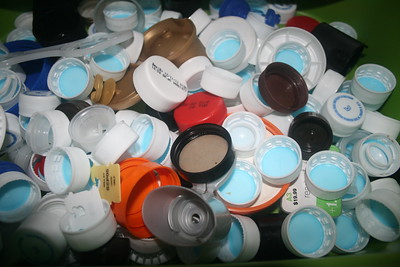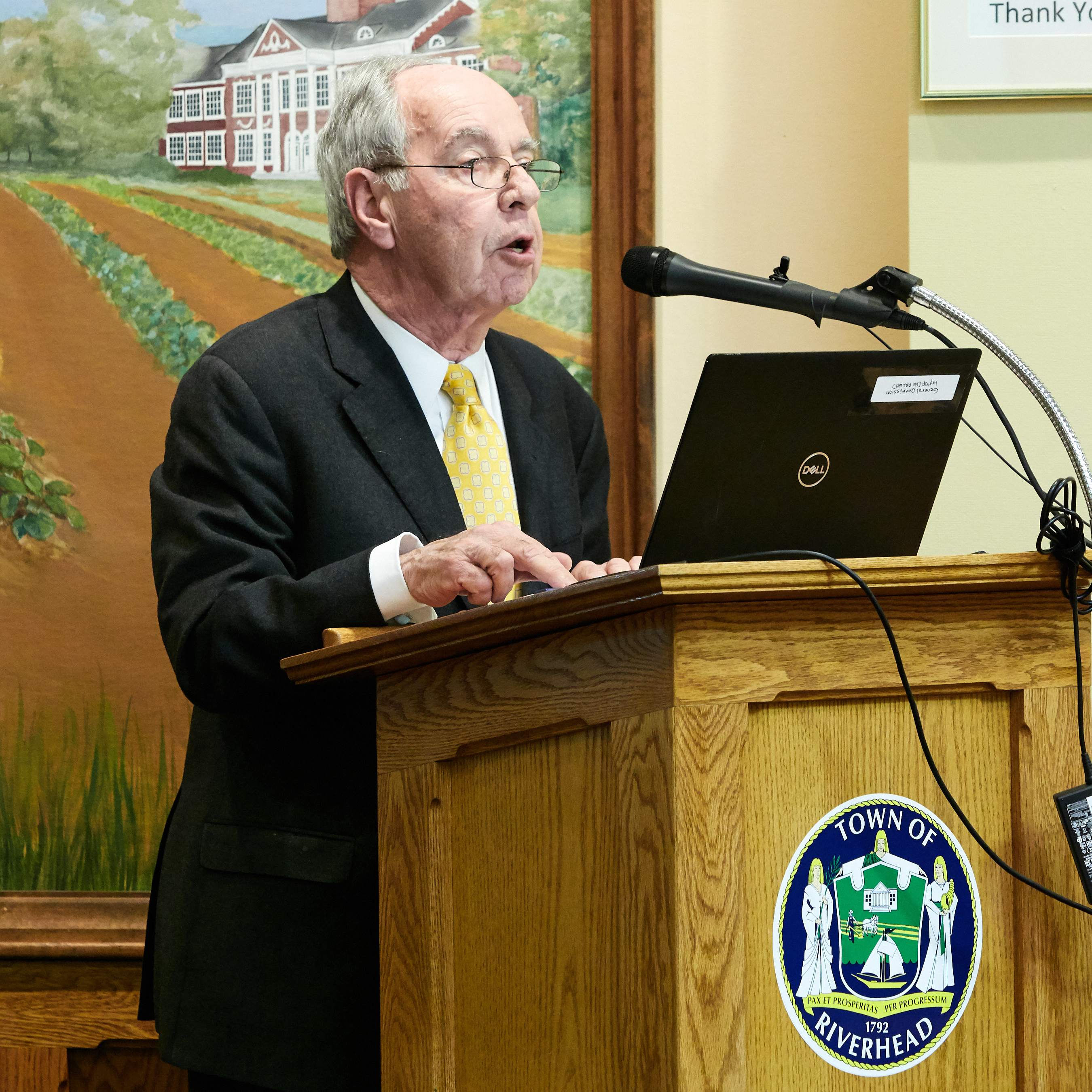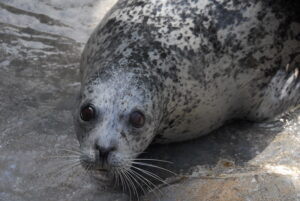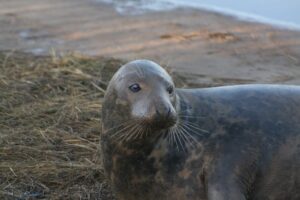Long Island’s Coastal Plain Ponds
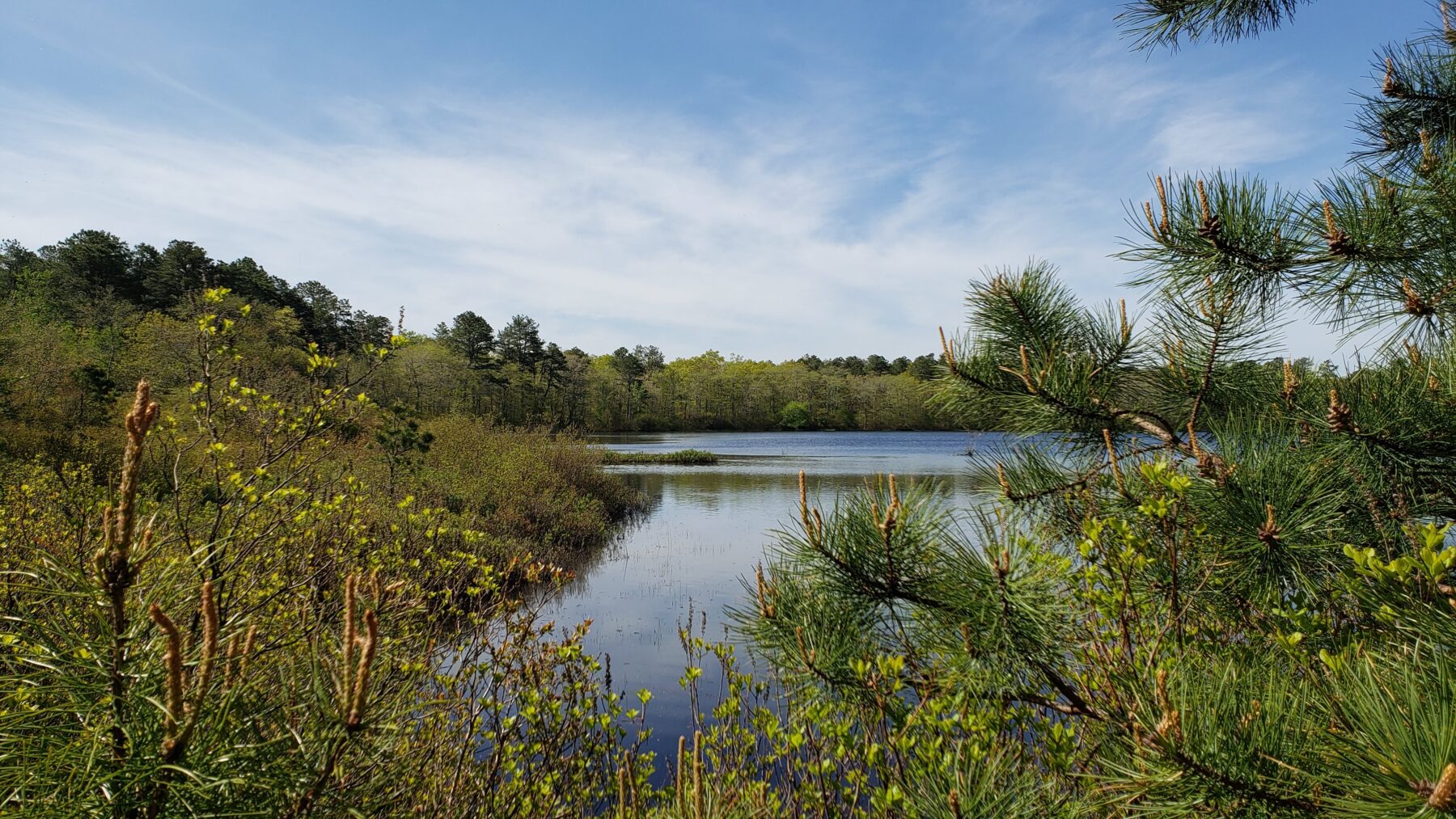
Long Island’s Central Pine Barrens boast the greatest diversity of plants and animals anywhere in New York State. What does this mean? The Long Island Pine Barrens house the greatest variety of animal and plant species in all of New York. It is home to thousands of different plants and animals, many of which are rare and endangered. Much of that biodiversity can be found in and around the Pine Barrens’ Coastal Plain Ponds.
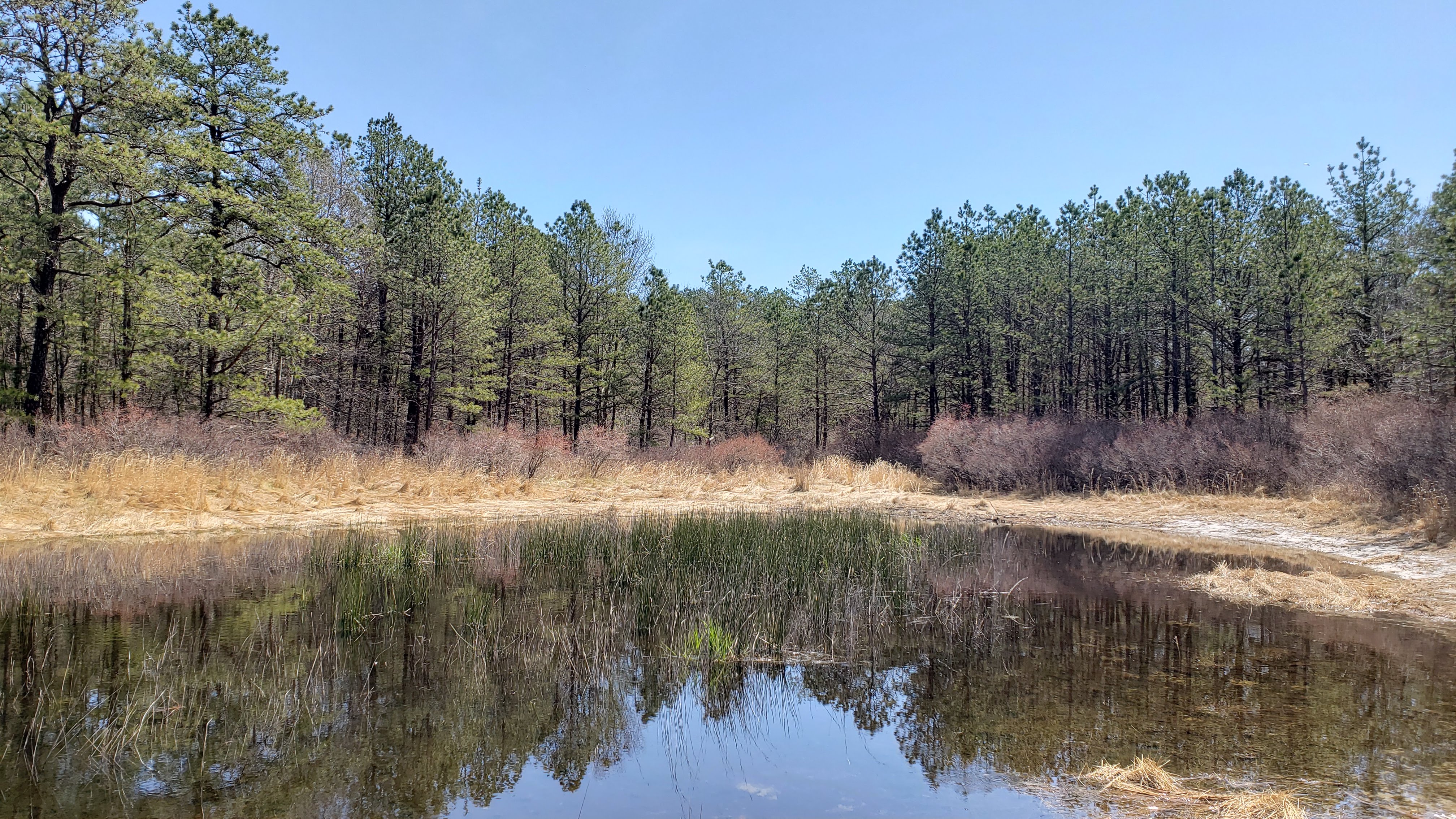
Coastal Plain Pond within Brookhaven State Park (K.Brown)
Long Island’s Coastal Plain Ponds are one of the rarest and most fragile wetland ecosystems in North America. According to the New York Natural Heritage Program, there are just over 30 documented coastal plain pond shores in New York. One thing you will notice when identifying a Coastal Plain Pond, is that there are no contributing bodies of water. These ponds are not stream or river-fed but instead, are fed by groundwater. The pond levels will often rise and fall with the water table, as they are dependent on precipitation levels. That’s why Coastal Plain Ponds can look radically different depending on the season. If pond levels are low, it’s important to not walk within the pond area, to avoid trampling rare plants.
Within the coastal plain pond ecosystem, you may find several rare amphibians, fish and insects. This includes the endangered Eastern Tiger Salamander and the threatened Banded Sunfish. The Coastal Plain Ponds are also home to a special species of damselfly endemic to Long Island, the Pine Barrens Bluet. This damselfly is named after our Pine Barrens because it can only be found along the coastal plain pond shores of our Pine Barrens.
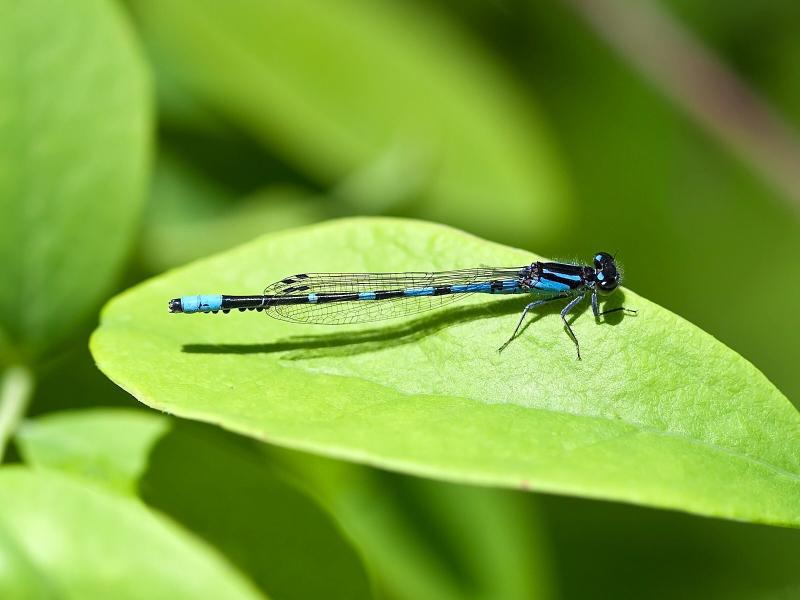
Pine Barrens Bluet Damselfly (Steve Walter)
Explorers will also encounter rare plant species, such as Atlantic White Cedar, Green Screwstem, Primrose-leaf Violet, and carnivorous plant species such as the Pitcher Plant, Sundew and Floating Bladderwort.
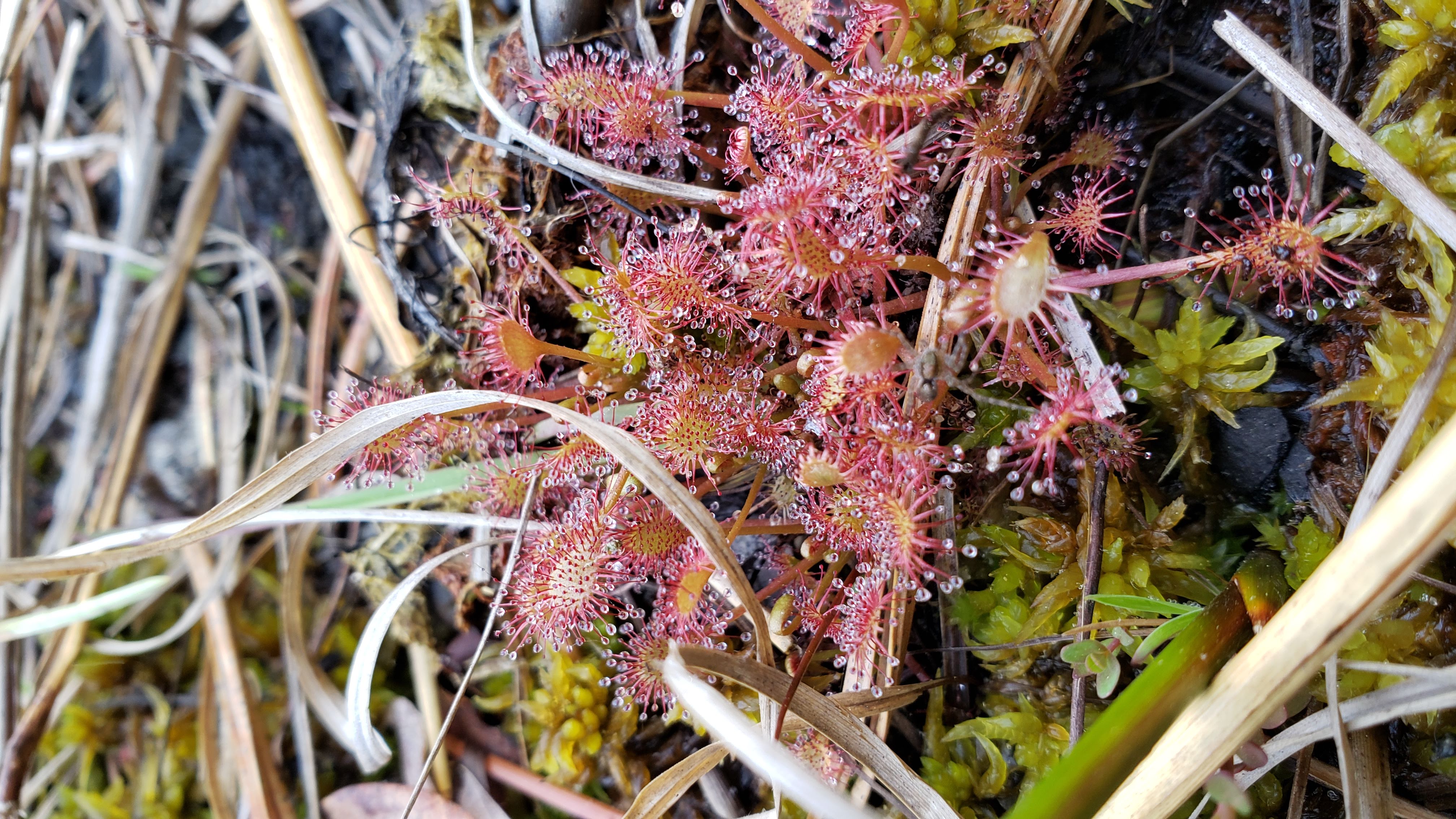
Spatulate-leaved Sundews along the shores of a Coastal Plain Pond (K.Brown)
While these ecosystems are beautiful and special, they are unfortunately threatened. These threats include: roadway and agricultural runoff, nitrogen pollution, increased groundwater withdrawal, trampling of vegetation and invasive plant and animal species. In particular, since these ponds are dependent on groundwater flow – anything that impacts our water quality will also impact the health of these ecosystems.
If you’re looking to check out a Coastal Plain Pond for yourself, you can pay a visit to Brookhaven State Park, Ridge Conservation Area, Calverton Ponds Preserve, Sears Bellow County Park, or the Long Pond Greenbelt. Please be mindful of these fragile and sensitive ecosystems – take special care to not trample any vegetation and leave no trace. Leave with only memories and pictures.
By: Katie Muether Brown, Long Island Pine Barrens Society
Posted on March 5, 2021 by Long Island Pine Barrens Society
The DOs and DONTS of Recycling
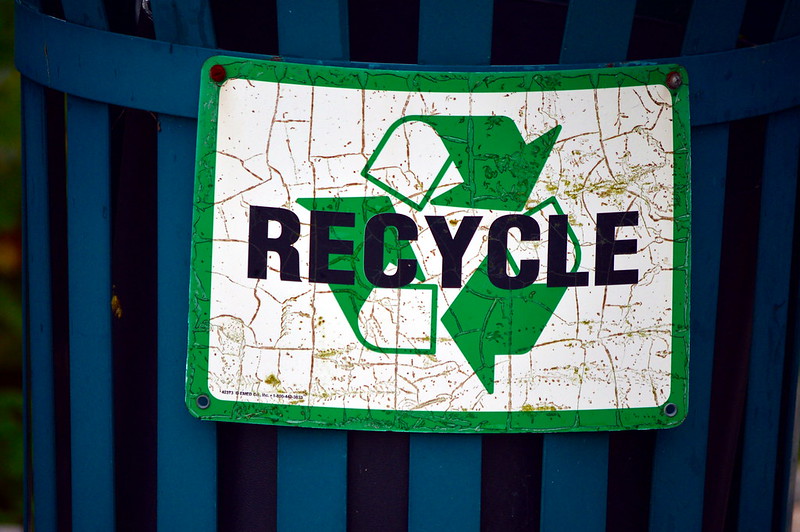
The slogan, Reduce Reuse and Recycle, has been around for decades, and by now many Americans have grown up with this mindset. The slogan first came about in the 1970s as a way to promote low-waste lifestyles after WWII influenced large amounts of stockpiling. Recycling often seems like the go-to practice, however it’s best to first reduce your consumption to only necessary purchases or reuse items until they no longer serve a purpose. Typically, items can only be recycled 2-3 times before the material quality breaks down too much. But, if you find that recycling is the only option, here are some Dos and Don’ts to ensure a correct recycling practice!

DO
- Use an item as many times as possible before recycling
As stated before, recycling should remain your last option because of all the risks that may lead a recyclable to a landfill. Reusing an item prolongs its life and reduces the need to purchase additional wasteful products.
- Rinse off recyclables before disposal
Cleaning your recycle containers is SO important. When a dirty container makes its way into your recyclable bin, it contaminates the whole batch which can then cause your recyclables to be thrown into a landfill. However, sometimes the water waste outweighs the recycling aspect, especially if you live in an area with freshwater scarcity. So before using all that pressurized hot water to clean out your pesky peanut butter jars, consider its worth.
- Separate your recyclables
Curbside recycling programs create an easy way to recycle from home, but you must know what type of recyclables your town accepts. For example, if you live in the Town of Brookhaven, you can only recycle plastics #1 and #2, and paper/cardboard. You cannot combine plastic and paper recycling, so be sure to store these in two separate bins. The group Green Inside and Out composed a chart of the recyclable items in towns throughout Long Island, you can find that here.

- Research your town’s recycling schedule
If you don’t know the correct days for recycling pickup, you could defeat the purpose of separating your recyclables in the first place. Luckily, you can find your town’s recycling schedule by a quick Google search. To stay even more proactive, print it out and hang it on your fridge as a reminder.
*Here are some local town Recycling schedules: Brookhaven, Islip, Riverhead

Don’t
While most plastic bottles are safe to recycle, their lids are NOT. Make sure to toss the lids and take the labels off!
- Be a wishful recycler
By this we mean, don’t place plastic in the recycling bin in hopes that it can be recycled. You should only recycle items you’re sure of, otherwise the entire bin will go to waste.
- Store paper recyclables in a wet place
Long Island has seen no shortage of snow this winter! Storing recyclables outdoors definitely makes more room indoors, but when your cardboard gets wet, either by keeping it outdoors or perhaps an accidental spill, it can no longer be recycled. Not only will water weaken the value of the material but wet cardboard often clogs the sorting machine at recycling facilities.
- Throw out items that can’t get recycled curbside
Curbside recycling has its limitations, but that doesn’t mean to toss material that you can’t recycle at home. Most plastic bags can’t be recycled at home, so you can simply recycle these at your local grocery store, and when it comes to electronic waste (E-waste) most towns or Best Buys accept E-waste drop offs!
By Miranda Gonzales, Long Island Pine Barrens Society
Source: enviroinc.com
Posted on February 24, 2021 by Long Island Pine Barrens Society
“Exceedingly poor indeed” – George Washington on the Long Island Pine Barrens

The Long Island Pine Barrens is a beautiful natural escape full of unique geological features and plant and animal species, but it’s also full of history! As we celebrate President’s Day, we should talk about our nation’s first president and his tour of our Pine Barrens.
In 1790, George Washington took a grand tour of Long Island. His tour was considered a “victory lap” – after winning the American Revolution, he traveled to Long Island to thank the members of the Culper Spy Ring of Setauket and others, who played a key role in the victory.

George Washington took a “Victory Lap” tour of Long Island after the American Revolution.
He began in New Utrecht (Brooklyn) and traveled to the towns of Hempstead, Copiague, West Bay Shore, West Sayville, Patchogue, Setauket, Smithtown, Huntington, and Roslyn. You can read more about his famous tour here.
If he had taken that route today, he likely would have never entered the Pine Barrens. However, in 1790, the Pine Barrens stretched much further west across Long Island. In fact, the Pine Barrens once stretched all the way into the Town of Oyster Bay. There, the Pine Barrens met the Hempstead Plains. Unfortunately, development throughout the years has cleared most of our Pine Barrens – 250,000 acres was dwindled down to 100,000 acres. Remnants of these original woodlands still occur in patches across the Island.
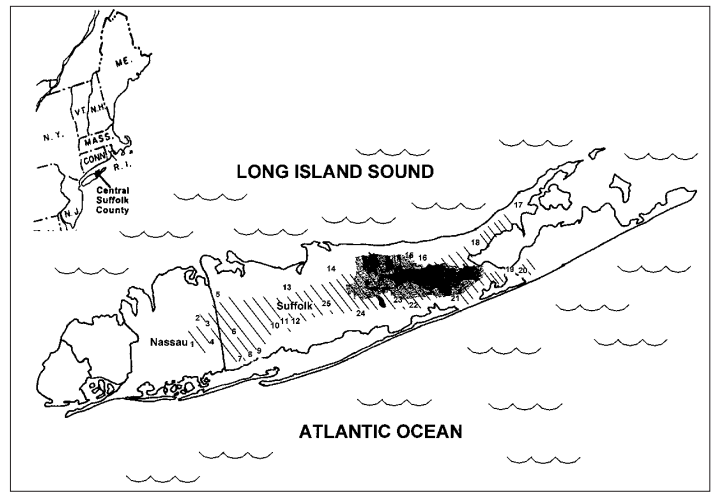
Credit: “Historical Changes in the Pine Barrens of Central Suffolk County, New York” (Kurczewski & Boyle, 2000)
So, what did George Washington have to say about our beloved Pine Barrens? In 1790, he wrote in his journal, “The country through which I passed became more barren as we travelled eastward, so as to become exceedingly poor indeed.” He also described the area as covered with “low scrubby oak, intermixed with small and ill-thriven pines.”
While it seems like he didn’t care for our Pine Barrens too much, there is some truth behind his descriptions. The Pine Barrens are… barren. The soil in the Pine Barrens is often sandy, acidic and nutrient-poor. Early European settlers termed the area barren because they were unable to plant their crops there. However, the soil is what makes the Pine Barrens so special – it supports a diverse spectrum of plant life that thrive in these soils, that you can’t find anywhere else! The sandy soils also make the Pine Barrens the ideal location for aquifer recharge. Water (from precipitation) is absorbed quickly through the sandy soils, restoring our aquifers with fresh, pure water untouched by development.
Perhaps it was just that George Washington didn’t spend enough time in our Pine Barrens to understand their true beauty and potential.
By: Katie Muether Brown, Long Island Pine Barrens Society
Posted on February 12, 2021 by Long Island Pine Barrens Society
6 Ways To Conserve Water in Your Homes

Two weeks ago, we announced on our blog that the Lewis Road Project in East Quogue has conditionally been approved and we outlined the environmental risks to come to Long Island. If you haven’t seen that post you can find it here. Excessive water use creates a global problem, not only local. In fact, of all the water on our earth, we only have 2.5% freshwater, and only 1% can be accessed. With a growing population, water availability becomes scarce in certain regions. As the global climate crisis accelerates, we’ll continue seeing an increase in droughts, flooding that will pollute waterways, and degradation of aquifers. This hurts our water supply even more. Long Islanders should feel especially passionate about the water crisis as we already have the most polluted water in New York State. Draining our aquifer will only make our water quality worse. So, what can we do to conserve water on the household level?
Bathroom Routine
1. Shorter Showers
Taking shorter showers to conserve water may be a well-known conservation tactic, but it’s important to keep this habit. Showers waste an estimated 5 gallons per minute. To conserve your shower water waste, you should set a timer on your phone so you know exactly when you hit the 5 minute mark.
2. Invest in Water-Saving Toilet
Did you know that older toilets typically waste 5-7 gallons of water per flush? Investing in a water-saving toilet can help everyone in your household cut back on their water waste. If this investment doesn’t seem affordable right now, you can always fill up a plastic bottle and place it in the toilet tank. This will decrease the amount of water needed to fill your tank, saving about 10 gallons of water per day.
Kitchen Routine
3. Cook Less Red Meat
Studies show that a ⅓ pound burger requires 660 gallons of water to make! Animal agriculture consumes a large amount of water, so by cutting back on red meat in your diet, you can help conserve water in the agriculture industry.
4. Fill-up Your Dishwasher
Most dishwashers use less water than washing your dishes by hand. This practice will be most effective if you make sure that the dishwasher is completely full, eliminating the need for multiple loads. If you don’t have a dishwasher, then wash your dishes like you would brush your teeth and turn the sink off when it’s not necessary.
Outdoor Routine
5. Water Your Lawn Earlier in the Day
While most of our lawns are currently covered in snow, it’s important to remember this tip when Spring comes around. Watering your lawn in the morning avoids high rates of evaporation that would occur midday, thus requiring more water.
6. Recycle Your Water
Keep a bowl in the sink while you wash your fruit and veggies. You can then recycle this water by pouring it into your gardens or on houseplants.
By Miranda Gonzales, Long Island Pine Barrens Society
Sources:
Posted on February 11, 2021 by Long Island Pine Barrens Society
Black History Month – Celebrating African American Environmentalists

February is Black History Month. While Black History is American History and should be embraced all year long, we still would like to celebrate this month by acknowledging the achievements of some famous African American environmentalists.
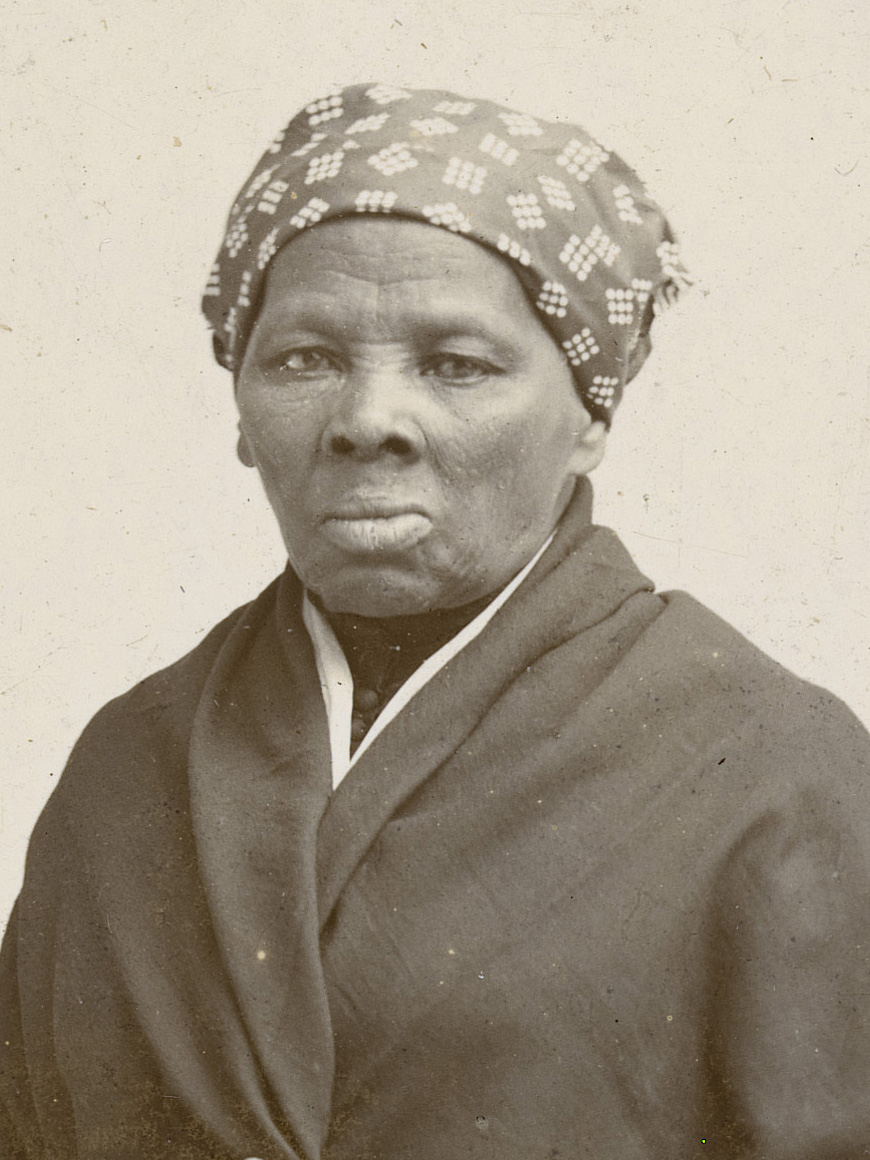
Harriet Tubman
Harriet Tubman may be the new face of the $20 bill. While she is most known for being a fearless “conductor” of the Underground Railroad, she was also a naturalist! Tubman used her knowledge of the local environment to communicate and navigate her travelers through the Underground Railroad. She also used owl calls to alert refugees when the coast was clear. With her help and expertise, 70 people were able to escape slavery.
“Nothing is more beautiful than the loveliness of the woods before sunrise.” – George Washington Carver
Another important environmentalist icon to recognize is George Washington Carver. Born into slavery, Carver went on to become one of the most prominent scientists of the 20th century. His research in crop rotation led to major breakthroughs in soil conservation and agriculture. He also invented and developed hundreds of products using peanuts, sweet potatoes, and soybeans (although he did not create peanut butter, which is a common misconception).
“We have flown the air like birds and swum the sea like fishes, but have yet to learn the simple act of walking the earth like brothers.” – Dr. Martin Luther King, Jr.
One must of course acknowledge the contributions of Dr. Martin Luther King, Jr. While not formally acknowledged as an environmentalist, Dr. King’s actions and the civil rights movement paved the way for the environmental movement. When you look at today’s environmental justice movement, you will see that many of the rights that Dr. King fought for are at the center of today’s movement – the protection of all people, regardless of race, color, nationality, socioeconomic status, from environmental health hazards and the equal access to clean air, land and water.

Dr. Warren Washington (Credit: cgd.ucar.edu)
Dr. Warren Washington is one of the world’s most influential climate scientists. Dr. Washington is one of the first developers of groundbreaking atmospheric computer models that predict future states of the atmosphere and has helped scientists understand climate change around the world. He and his fellow scientists won a Nobel Peace Prize for their research in 2007.

Audrey and Frank Peterman (Credit: Audubon)
Power couple Audrey and Frank Peterman are among the leading experts on America’s publicly-owned lands system. After traveling 12,000 miles across 40 states from Florida to Washington State, they were transformed by the stunning natural beauty, history and culture protected in our National Parks and forests. They were also shocked to see the lack of diversity in park visitors. They are tenacious advocates for getting all Americans – regardless of race, age, or ethnicity – to take advantage of and appreciate our natural heritage.
“If we are going to be part of the solution, we have to engage the problems.” – Majora Carter
Majora Carter is an urban revitalization strategist who works to build and plan cities through an environmental lens. This South Bronx native worked to develop the Hunts Point Riverside Park, the first open-waterfront park in the South Bronx in more than 60 years. She is an environmental justice warrior, who works to bring nature into cities and incorporate a green economy into urban cities and rural communities alike.
While learning about these famed environmentalists is a good start, we encourage you to do more research into the countless other African Americans who have worked hard to protect our natural environment for all Americans (check out our resource links below). Or perhaps celebrate Black History Month by picking up a nature book written by a BIPOC author (some great suggestions, here.)
By: Katie Muether Brown, Long Island Pine Barrens Society
Sources:
https://sfenvironment.org/article/celebrating-black-environmentalists-during-black-history-month
Posted on February 2, 2021 by Long Island Pine Barrens Society
Golf and Our Environment

Golfing for sport seems to be on the decline within younger generations and for good reason. Many people view golf as a boring or elitist sport, but golf also creates huge detrimental environmental impacts, as far as sports go. Often located on deforested land, behind the gates of a formal country club, golf courses require a lot of maintenance to uphold the country club standards. In lieu of the recent approval by the New York State Pine Barrens Commission for Discovery Land building company to move forward with their Lewis Road project to create a luxury resort in East Quogue, it seemed fitting to break down all the environmental risks to come.
In the US, golf courses occupy about 1,504,210 acres of land, so we have ample evidence of their negative impacts. Creating golf courses often involves destroying wild habitats and clearing out native species in an area. This can hurt ecosystem functions, and even cause the endangerment of possible at-risk species. With a clear terrain, sediment run-off into waterways becomes an issue. On top of this, golf courses require constant upkeep to maintain the aesthetic. Companies will use herbicides, fertilizers, pesticides and large amounts of water to care for the grass. This causes large amounts of water waste and pollution in our groundwater. On average, the golf courses in the US use an estimated 1.859 million acre-feet of water a year in maintenance.(GCSAA, 2014) Additionally, the daily mowing of the lawn constantly burns harmful fuels releasing their emissions into our atmosphere.
With all that said, Long Islanders should realize the grave danger to Long Island’s environment should the Lewis Road Project in East Quogue begin. Over the past several years, countless environmentalists, scientists, civic leaders and even the founders of the Pine Barrens Act, provided expert testimony, pointing out the many ways this project fails to comply with the Pine Barrens Act and Land Use Plan. Hundreds of community members spoke out against the project. Still, in a catastrophic disappointment, Pine Barrens Commissioners voted (3-1) to move forward with the project. However, this project is still the subject of pending litigation brought by Group for the East End and joined by our Pine Barrens Society. There are serious violations to the State Environmental Quality Review Act (SEQRA) that need to be adjudicated before this project can move forward. We are looking into other legal avenues as well.
Now with all the golf hating out of the way, golf is still a beloved sport by many, so it’s worth mentioning the ways to make it more sustainable. Some golf courses have already made the switch to supplying their turf with native vegetation that may require less water. Other ways to reduce water waste, is to use recycled water or greywater when watering the lawn. To avoid the use of pesticides, companies can take a biological control approach. Most importantly, establishing companies should reach out to environmental groups in their area or research into the environmental regulations to ensure their course creates the least environmental damage to their area. Golf courses should never be built in sensitive environmental areas, such as the Pine Barrens.
By Miranda Gonzales, Long Island Pine Barrens Society
Posted on January 27, 2021 by Long Island Pine Barrens Society
Pups in the Pine Barrens
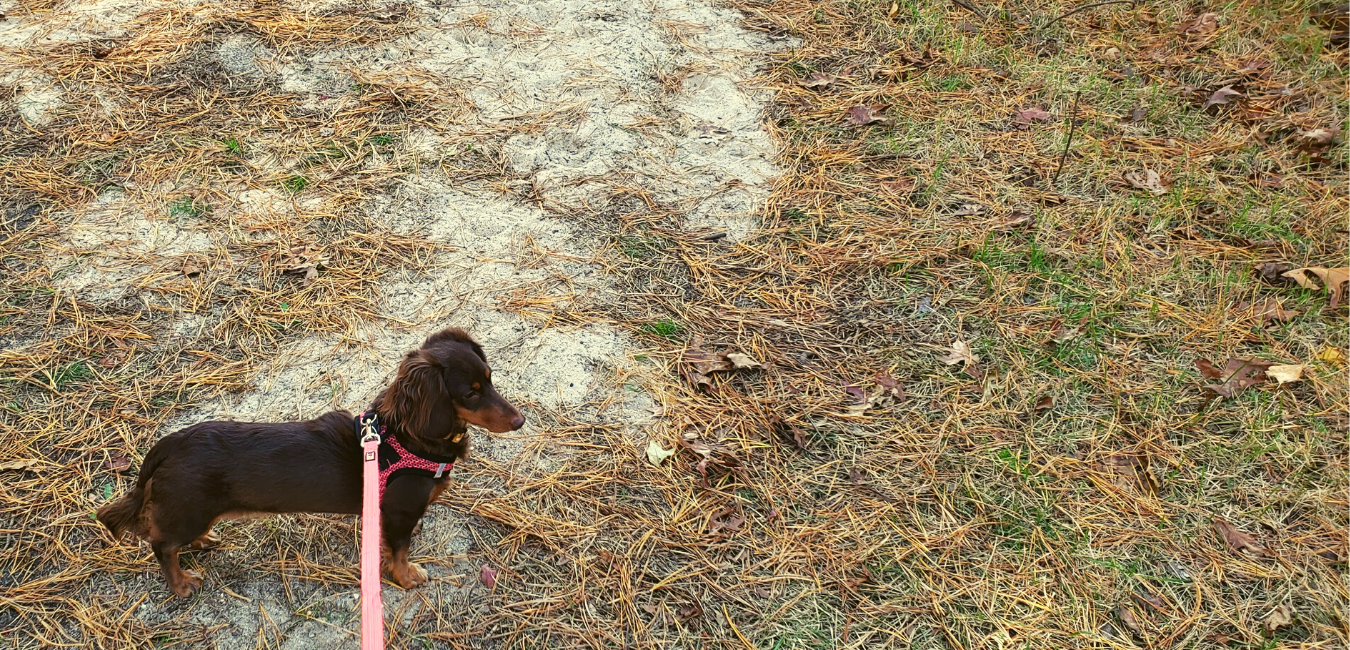
Is your dog your best friend? Have you ever wanted to bring your dog along on a hike with you? Well, you might be happy to learn that several parks in the Long Island Pine Barrens are “Fido-Friendly.”
A walk in the woods is good for both you and your dog. Bringing your dog on a walk can help mentally stimulate your dog, prevent obesity and other health issues, and can even help curb behavioral problems.
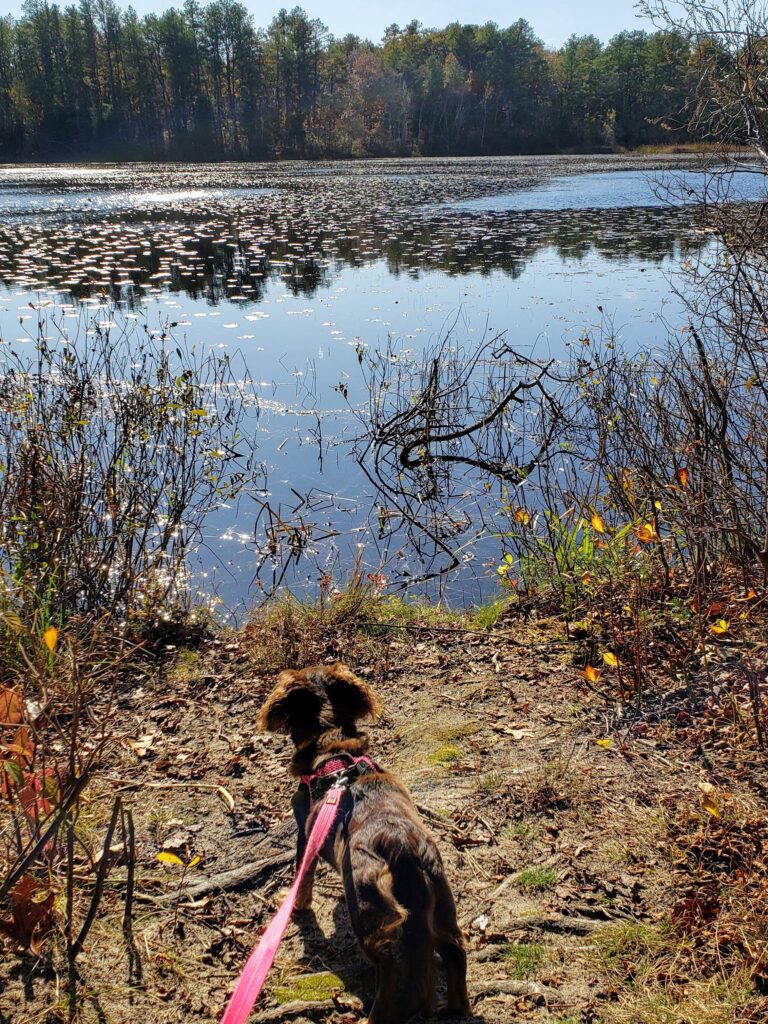
Staff Pup, Heidi, Exploring Cranberry Bog Nature Preserve.
Before bringing your dog along on your next nature outing, it’s important to keep some things in mind –
- Not all parks allow dogs. Always check signage (or a park’s website) to make sure dogs are allowed before entering the woods and respect the rules. Dogs can signal the presence of a predator and can cause a disturbance to certain wildlife, disrupting feeding and nesting patterns. If dogs are not allowed, there’s likely an important reason why.
- Always keep your dog on a leash. You might think your dog is super friendly and always listens to your commands well, but the purpose of the leash is to respect others that are out enjoying our parks. Some people are afraid of dogs and it may ruin their experience to see an unleashed dog on the trail. In addition, a leash helps keep your dog out of harm’s way and helps protect our wildlife.
- Always pick up after your dog and most importantly, dispose of the waste properly. There are usually garbage cans at most trailheads and in some parks, cans around the property. If your dog makes a mess, pick it up (hopefully with a biodegradable poo bag) and carry it with you until you can properly dispose of it. Dog waste can carry and spread harmful bacteria to others and can even pollute nearby waterbodies. We are seeing more and more people bag their dog’s waste and leave it on the trail. This is completely disrespectful to others’ experience. No one wants to stare at neon-colored bags along a trail. Please remember to leave no trace.
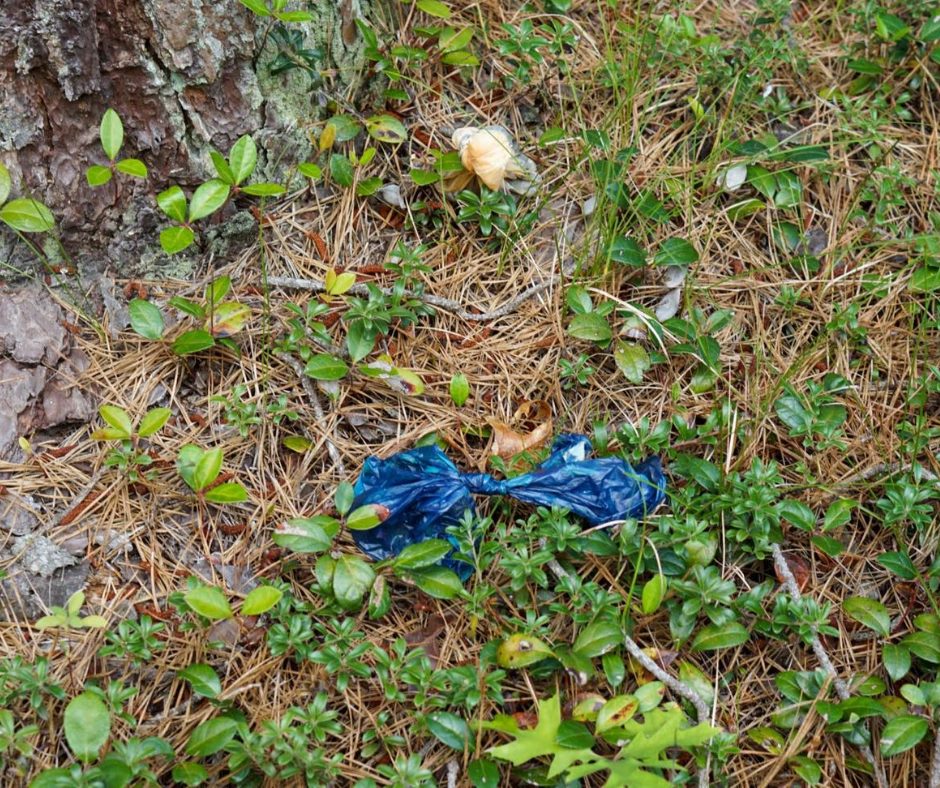
Please don’t do this. Always pick up and dispose of your dog’s waste properly.
Now that we have the rules in order, let’s talk about some options on where to take your pup! You can always download our handy “Dog-Friendly Parks” guide for quick reference. However, here are some of our favorite Fido-Friendly parks:
- Rocky Point State Pine Barrens Preserve, Rocky Point
- Cathedral Pines County Park, Middle Island
- Prosser Pines Nature Preserve, Middle Island
- Southaven County Park, Yaphank
- Manorville Hills County Park, Manorville
- Cranberry Bog Nature Preserve, Riverhead
- Indian Island County Park, Riverhead (technically not Pine Barrens, but close!)
Enjoy the Long Island Pine Barrens with your pup, safely and respectfully! Share your hiking adventure photos with us by using the hashtag #PineBarrensPups.
By: Katie Muether Brown, Long Island Pine Barrens Society
Posted on January 22, 2021 by Long Island Pine Barrens Society
Seal Watching on Long Island

As the holiday season winds down and social distancing rules remain intact, you may find yourself having extra free time. So what can you do that will create a memorable experience without risking your families health? As suggested in our recent Winter Recreation Guide, participate in an outdoor seal walk. You can find groups that offer guided tours or venture out to the water on your own in hopes of stumbling across some resting seals.
Long Island hosts five native seal species including; Harbor, Grey, Harp, Hooded, and Ringed seals. However, you’ll most likely come across either Harbor, Grey or Harp seals as Ringed and Hooded seals tend to stay toward arctic seas. For the most part, these seals will look pretty similar with their long torpedo-like bodies, flippers and caterpillar-like movement, but if you get a close look ( through binoculars, of course) you can discover distinctive traits between species. You’ll know you have spotted a Harbor seal if you see a dog-like snout with V-shaped nostrils and spots on the fur. In compassion, Grey seals have round heads with parallel nostrils and they’re typically grey or brown in color. Lastly, while very rare, you’ll know you’ve come across a Harp seal if you see black pigmentation on the snout and a black mark on their back that resembles a harp.
Now that you know the traits to identify the seals, it’s time to pick a location to start your seal-watching hunt. Seals have been spotted at the following park in the past,, so they may be worth a visit: Jones Beach State Park, Montauk Point State Park, or Cupsogue Beach State Park. You can also opt to attend a seal cruise or guided tours you can find online. We suggest checking out the Coastal Research and Education Society of Long Island. And, right now is the best time of year to see seals. From November to about April seals rest on sandy beaches to regulate body temperature or prepare for birth. If you’re lucky enough to spot some seals on your walk, keep your distance and do not disturb them. Seals are a federally-protected species and are protected against harassment and being killed. Harassment is defined as anything that can cause a change in the mammal’s behavior. Always maintain a 200 feet distance when observing seals. As adorable as they look, they are still unpredictable wild animals!
By Miranda Gonzales, Long Island Pine Barrens Society
Posted on January 12, 2021 by Long Island Pine Barrens Society
2020 Was a Good Year for Nature
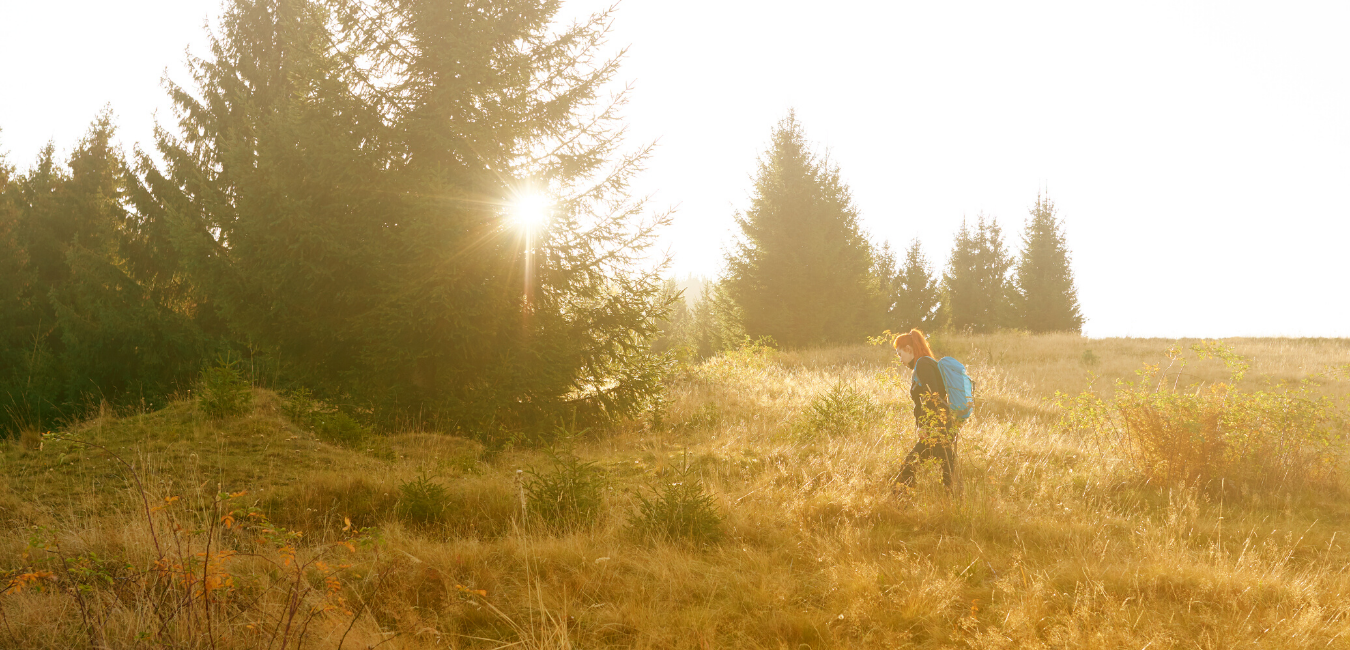
2020 – a year we most certainly will never forget. The year has been referred to as a “dumpster fire,” a nightmare, surreal and relentless. I think we can agree that those terms are appropriate for a year marked by such profound loss. Was there any bright side? For us environmentalists, we were happy to see so many new people finding the value in nature for the first time.
With many businesses, restaurants and other indoor recreation closed due to the pandemic, families were looking for somewhere to escape to. The answer? People explored the outdoors, our national, state and local parks, in record numbers. Certain national parks saw a 9 to 21% increase in visitors this past year. And while no official data has been released on the amount of visitors to New York State’s parks in 2020, there has been plenty of local news and anecdotal stories that depict long park entrance lines that had never been seen before. There was also a surge in the purchase of camping and outdoor recreation gear.
At our Pine Barrens Society, we saw a spike in the amount of people visiting our recreation pages on our website. We also fielded countless calls from people looking to explore our Pine Barrens for the first time. We responded to this increased interest with all new recreation guides and by creating a popular #TrailFeatureFriday series on Facebook.
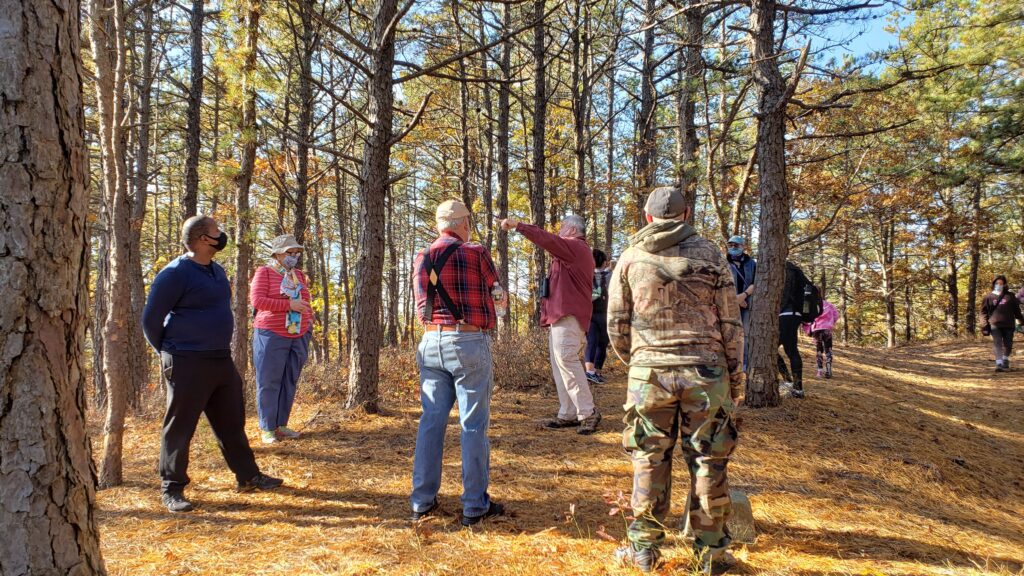
Group hike led by the Pine Barrens Society in November 2020
We know from experience that when people see and experience the beauty and value of nature first hand, they’re more likely to become environmental stewards themselves. We were happy to help people experience the Long Island Pine Barrens for the first time.
I for one, felt I got to experience the changing of the seasons like never before. I was able to spend some more time outside and felt that I noticed little natural subtleties more – noting when certain songbirds arrived to my bird feeder or the particular way certain plants bloomed in Spring. I even got to witness a family of Robins grow up in a nest in my backyard (watching from afar). These are things I surely would have missed in the daily hustle-and-bustle of my usual pre-pandemic commute.
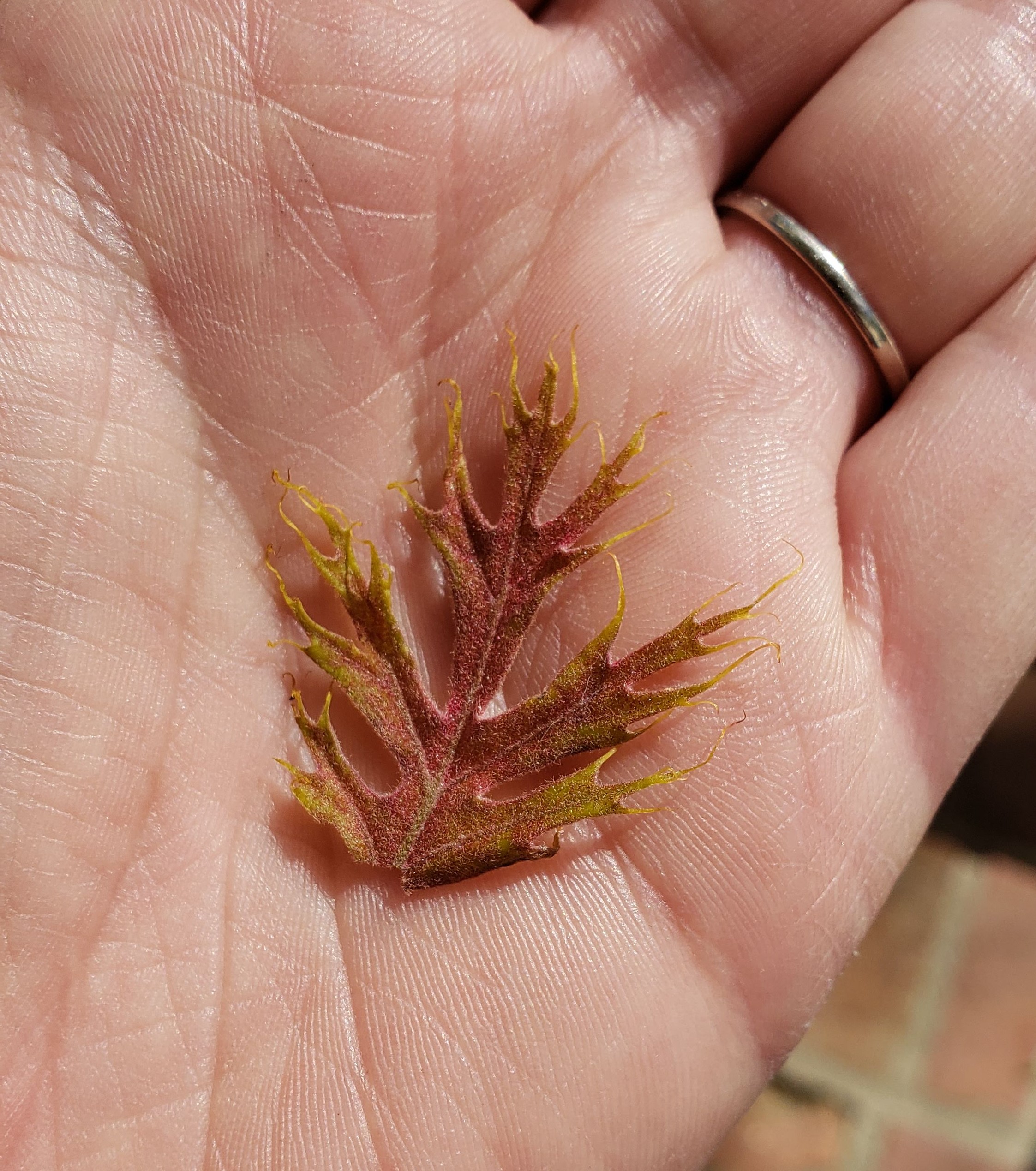
Premature Oak Leaf (hand for scale) observed Spring 2020
In another win for nature, global greenhouse gas emissions plunged by roughly 2.4 billion tons last year, a 7% drop from 2019 and the biggest reduction in emissions since 1945. This was mostly caused by a decline in transportation (air travel and daily commuting). However, we can’t get too excited – scientists say this will have little to no effect on the status of climate change, especially if emissions rebound in 2021. We should strive to continue and accelerate this decline in emissions. Perhaps we should permanently adopt some of the lifestyle changes brought on by the pandemic – shop small and local, work from home when we can, and instead of driving (or in extreme cases, flying) to meetings, we should opt for remote communications instead. And of course, we should continue to invest in cleaner energy and infrastructure.
Well, it’s 2021 – what now? It’s our hope that people will continue to embrace Long Island’s beautiful outdoors. Even though it’s Winter, you can still head outside (check out our latest Winter recreation guide for some ideas). It is also our hope that those who have learned to love and appreciate nature will help us protect it. Respect nature when you’re in it and leave no trace. Make small changes at home to reduce your carbon and water footprint. Speak up for the environment. If there’s anything that 2020 taught us, it’s that nature is an invaluable resource – both for our physical and mental health. It must be protected.
By: Katie Muether Brown, Long Island Pine Barrens Society
Help us continue to protect Long Island’s natural treasures – make a contribution to the Long Island Pine Barrens Society today!
Posted on January 4, 2021 by Long Island Pine Barrens Society
Endangered Species in the Long Island Pine Barrens
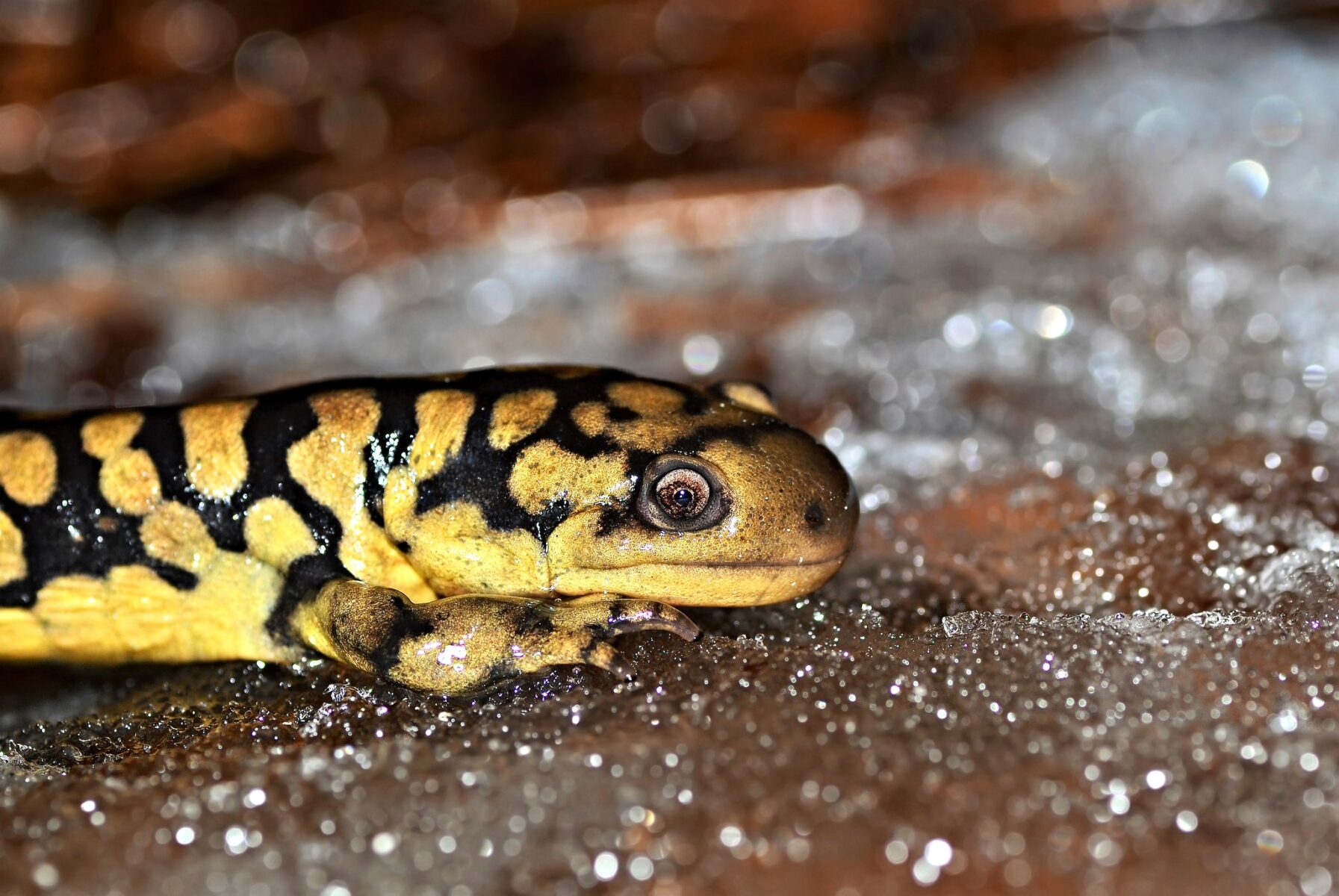
The term “Endangered Species,” by definition, describes a species at risk of becoming extinct. When most people hear this term, they probably picture a flagship species, like panda bears. The unfortunate reality is that we have endangered species even here in the Long Island Pine Barrens. A species can become endangered through habitat destruction (naturally caused or human evoked), overhunting, invasive species outcompeting with native species, or lack of genetic variation. Knowing the risk factors of endangerment makes it easier to implement conservation plans. Sometimes, species can become endangered to a specific location. We see that with the following species and their declining population in the Long Island Pine Barrens.
The Eastern Mud Turtle
These small hard-shelled reptiles have populations ranging from Long Island all the way to Eastern Texas. Their species covers a large part of the country however, the Eastern Mud Turtle population in New York holds an endangered status. The decline of these small turtles is due to their migration over roads where they’re often unseen and hit by drivers, destruction of their New York habitat or illegal pet trade. The DEC recommends conservation plans that would include placing turtle crossing signs on roads intersecting turtle habitats and maintaining and protecting current areas these turtles knowingly reside.
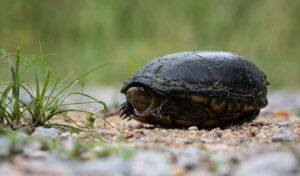
Photo by: Alex Roukis
Northern Harrier Hawk
The once abundant New York Population on Harrier Hawks began to decline in the 1950s. The decline of their population is owed to the destruction of their breeding habitat and poison from pesticides. Current plans from the DEC aim to protect nesting areas and also ensure that Harrier Hawk prey populations, like grassland raptors, remain stable as well so these hawks have an abundance of food.

Photo by: CC Stan Lupo
The Eastern Tiger Salamander
The Eastern Tiger Salamanders found themselves on the New York State endangered species list, as well. Out of all New York state, you will only find these amphibians on Long Island, specifically in the Pine Barrens. The DEC estimates only 90 ponds located on Long Island occupy a breeding habitat for these creatures. When these ponds become overpopulated with predators or destroyed by off-roading vehicles, the salamanders will struggle to repopulate. Some conservation plans include the construction of salamander tunnels under roadways, instalment of salamander crossing signs and restoration of wetlands habitats.
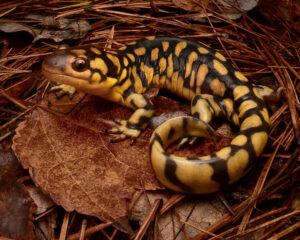
Photo by: Alex Roukis
If you feel alarmed about losing these native Long Island species, you can make changes in your everyday life that will help species survive. First, pay attention for animals in the road, even when you don’t see signs, or if you visit a park, avoid walking through designated nesting areas. In fact, try not to disturb any wildlife you may come in contact with and try to observe from afar. You can also avoid using pesticides in your gardens, and swap it for a natural alternative to avoid possible poisoning of wildlife. Lastly try to keep your cats indoors to avoid unnecessary predation on our wildlife.
By Miranda Gonzales, The Long Island Pine Barrens Society
Posted on December 29, 2020 by Long Island Pine Barrens Society

